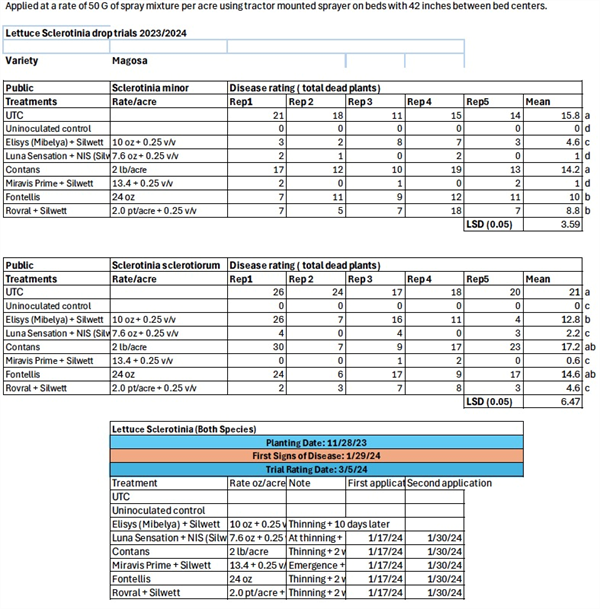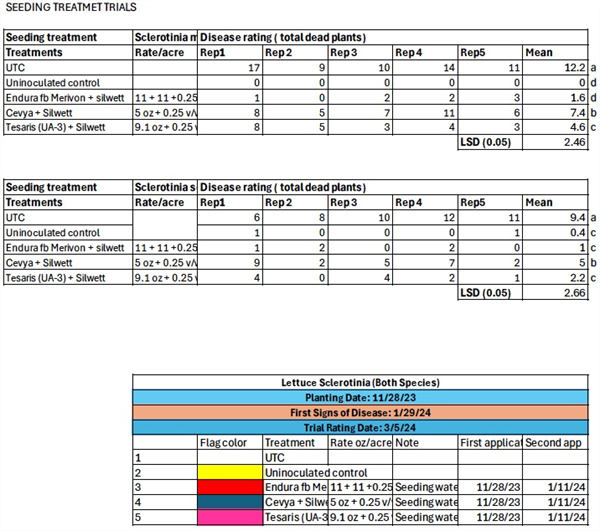Bindu Poudel-Ward, Martin Porchas Sr., Martin Porchas Jr., and Neeraja Singh
Yuma County Cooperative Extension, University of Arizona, Yuma, AZ
This study was conducted at the Yuma Valley Agricultural Center. The soil was a silty clay loam (7-56-37 sand-silt-clay, pH 7.2, O.M. 0.7%). Lettuce was seeded, then sprinkler-irrigated to germinate seed on Nov 28, 2023 on double rows 12 in. apart on beds with 42 in. between bed centers. All other water was supplied by furrow irrigation or rainfall. Treatments were replicated five times in a randomized complete block design. Each replicate plot consisted of 25 ft of bed, which contained two 25 ft. rows of lettuce. Plants were thinned Jan 17, 2024 at the 3-4 leaf stage to a 12-inch spacing. Treatment beds were separated by single nontreated beds. Treatments were applied with a tractor-mounted boom sprayer that delivered 50 gal/acre at 100 psi to flat-fan nozzles spaced 12 in apart.
|
Month |
Max Temp (°F) |
Min Temp (°F) |
Average Temp (°F) |
Rainfall |
|
November |
80 |
51 |
65 |
0.08 in |
|
December |
71 |
44 |
57 |
0.82 in |
|
January |
68 |
42 |
54 |
1.14 in |
|
February |
73 |
47 |
59 |
0.50 in |
Sclerotia of Sclerotinia minor were produced in 0.25 pt glass flasks containing 15 to 20 sterilized 0.5 in. cubes of potato by seeding the potato tissue with mycelia of the fungus. After incubation for 4 to 6 wk at 68°F, mature sclerotia were separated from residual potato tissue by washing the contents of each flask in running tap water within a soil sieve. Sclerotia were air-dried at room temperature, then stored at 40°F until needed. Inoculum of Sclerotinia sclerotiorum was produced in 2 qt glass containers by seeding moist sterilized barley seeds with mycelia of the pathogen. After 2 months incubation at 68°F, abundant sclerotia were formed. The contents of each container were then removed, spread onto a clean surface and air-dried. The resultant mixture of sclerotia and infested barley seed was used as inoculum. Lettuce ‘Magosa’ was seeded and then sprinkler-irrigation was initiated to germinate seed in double rows 12 inches apart on beds with 42 inches between bed centers. Plants were thinned Jan 17, 2024 at the 3-4 leaf stage to a 12-inch spacing. For plots infested with Sclerotinia minor, 0.13 oz (3.6 grams) of sclerotia were distributed evenly on the surface of each 25-ft-long plot between the rows of lettuce and incorporated into the top 1 inch of soil. For plots infested with Sclerotinia sclerotiorum, 0.5 pint of a dried mixture of sclerotia and infested barley grain was broadcast evenly over the surface of each 25-ft-long lettuce plot, again between the rows of lettuce on each bed, and incorporated into the top 1-inch of soil. Treatment beds were separated by single nontreated beds. Treatments were replicated five times in a randomized complete block design. Each replicate plot consisted of a 25 ft length of bed, which contained two 25 ft rows of lettuce. Control plots received sclerotia but were not treated with any fungicide.
For treatments first applied at seeding, sclerotia were introduced into plots before the first application of treatments. The first application for at seeding treatments was made on Nov 28, with an additional application on January 17, 2024. Some treatments had second application on Jan 30, 2024 (See table). For treatments first applied after thinning, sclerotia were introduced into plots after thinning before the first application of these treatments, with additional applications as noted in the data sheets. An initial sprinkler irrigation supplied water for seed germination, with subsequent furrow irrigations for crop growth. First sign of disease was observed on January 29, 2024. The final severity of disease was determined at plant maturity by recording the number of dead and dying plants in each plot due to Sclerotinia minor or Sclerotinia sclerotiorum (March 5, 2024). As a point of reference, the original stand of lettuce was thinned to about 65 plants per plot.
In nontreated plots, about 32% of lettuce plants were dead or dying due to infection with Sclerotinia sclerotiorum and about 24 % due to S. minor, at the end of the trial. Please refer to the data tables to compare treatments of interest, using the Least Significant Difference Value listed at the bottom of each table to determine statistically significant differences among treatments. Miravis Prime, Luna Sensation and Elisys gave the best results against Sclerotinia minor. Luna Sensation, Miravis Prime and Fontellis gave the best control against S. sclerotiorum (see table). From the list of treatments applied at seeding, Endura fb Merivon gave the best control against both species of Sclerotinia (see table).
Phytotoxicity was not observed in any of the treatments in this trial.







